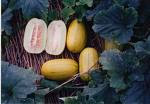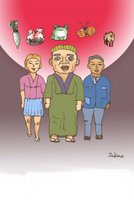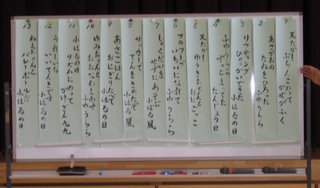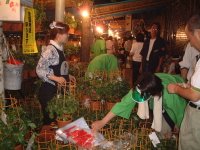[ . BACK to Worldkigo TOP . ]
:::::::::::::::::::::::::::::::::::::::::::::::::::::::::::::::::::::::::::::::::::::::::::::::::::::
Oriental Melon , gourd (uri)
***** Location: Japan, other regions
***** Season: See below
***** Category: Plant
*****************************
Explanation
Oriental melon, Cucumis melo var. makuwa
makuwa uri 真桑瓜

hisago 瓠
Hisago gourd, bottle gourd
Lagenaria siceraria
kigo for late summer
Melon is a term used for various members of the Cucurbitaceae family with fleshy fruit. Melon can refer to either the plant or the fruit, which is a false berry. Many different cultivars have been produced, particularly of muskmelons. The plant grows as a vine.
Genus Momordica Bitter melon
Genus Benincasa Winter melon
Genus Citrullus -
Watermelon
Genus Cucumis
.... C. metuliferus - Horned melon
.... C. melo : Muskmelon (Cucumis melo)
..... Makuwa Group is the "
Japanese cantaloupe".
© More in the WIKIPEDIA !
:::::::::::::::::::::::::::::::::::::::::::::::::::::::::::::::::::::::::::::::::::::::::::::::::::::
kigo for late summer
melon, meron メロン
musk melon マスクメロン
western melon, seiyoo meron 西洋メロン
oriental melon, gourd, Japanese cantaloupe, gourd 瓜 uri
hisago no hana 瓢の花 (ひさごのはな) gourd flowers
..... fukube no hana ふくべの花(ふくべのはな)
hyootan no hana 瓢箪の花(ひょうたんのはな)hyotan flowers
hana hisago 花瓢(はなひさご)
humanity kigo
melon thief, uri nusutto 瓜盗人 (うりぬすっと)
uriban 瓜番 (うりばん) guardian of gourds / melons
..... urimori 瓜守(うりもり)
urigoya 瓜小屋(うりごや)hut for the gourd guardian
..... uribangoya 瓜番小屋(うりばんごや)
When the melons get ripe in the fields, small huts are set up for the guardians, who have to watch out day and night for thieves.
:::::::::::::::::::::::::::::::::::::::::::::::::::::::::::::::::::::::::::::::::::::::::::::::::::::
gourd flowers, uri no hana 瓜の花
hisago nae 瓢苗 (ひさごなえ) gourd seedlings
kigo for early summer
 watermelon, suika スイカ 西瓜
kigo for early autumn
watermelon, suika スイカ 西瓜
kigo for early autumn
 スイカだるま Watermelon-Daruma
hayatouri, hayato uri 隼人瓜 (はやとうり)
スイカだるま Watermelon-Daruma
hayatouri, hayato uri 隼人瓜 (はやとうり)
Sechium edule
kigo for late autumn
. . . CLICK here for Photos !
.................................................................................
. hechima, ito-uri 糸瓜, 蛮瓜,布瓜 Sponge gourd
. hyootan, fukube 瓢箪 gourd, calabash
. kabocha 南瓜 (かぼちゃ) pumpkin, squash
. toogan とうがん(冬瓜) white gourd-melon; a wax gourd
:::::::::::::::::::::::::::::::::::::::::::::::::::::::::::::::::::::::::::::::::::::::::::::::::::::
 Snake and Two Melons
Snake and Two Melons
魚屋北渓 Hokkei (1780 - 1850)
- quote -
Hokkei was one of the best students of Hokusai, and his pieces were of a very high quality of craftsmanship.
The snake is symbolic of great cunning at a supernatural level. Having it amongst the melons makes it auspicious for family unity.
- source : paradisebound.ca/product/totoya-hokkei -
:::::::::::::::::::::::::::::::::::::::::::::::::::::::::::::::::::::::::::::::::::::::::::::::::::::
Some FOOD related kigo for all summer
rubbing gourds uri momi 瓜揉 (うりもみ)
..... uri momu 瓜揉む(うりもむ)
rubbed gourd, momi uri 揉瓜(もみうり)
cutting gourds, uri kizamu 瓜きざむ(うりきざむ)
rubbing cucumbers, kyuuri momi 胡瓜揉(きゅうりもみ)
gourd with namasu dressing, uri namasu 瓜膾(うりなます)
The vegetables are cut in small pieces and a dressing of vinegar and soy sauce is poured over them.
pickled gourd, urizuke 瓜漬 (うりづけ)
..... tsuke-uri, tsuke uri 漬瓜(つけうり)
pickled cucumbers, kyuurizuke 胡瓜漬(きゅうりづけ)
pickled Shiro-uri, shiro urizuke 越瓜漬(しろうりづけ)
Various types of
uri are pickled in
. nukamiso . or prepared as
Narazuke.
These pickles bring appetite back during the hot summer months.
drying gourds, hoshi-uri 乾瓜 (ほしうり)
..... 干瓜(ほしうり)
"drying before a thunderstorm",
kaminariboshi 雷干(かみなりぼし)
After cutting the vegetable and salting them for one night, they are dried in the sun. For eating, they are again put in water to remove the salt and a dressing of vinegar is used.
For kaminari, the gourd is cut in a spiral and hung to dry, but usually in the evening there is a summer thunderstorm (yuudachi), so when the farmers hear the thunder they have to run and bring the spirals under a roof.
Japanese Rerefence: How to make summer vegetable pickles
:::::::::::::::::::::::::::::::::::::::::::::::::::::::::::::::::::::::::::::::::::::::::::::::::::::
A Japanese saying for two people who resemble each other without being twins is
like two melon-halves, uri futatsu 瓜二つ
There is a difference between the watermelon, suika, and
a sweet melon, meron, and an uri-type of the Oriental melon, a type of gourd.
:::::::::::::::::::::::::::::::::::::::::::::::::::::::::::::::::::::::::::::::::::::::::::::::::::::
Matsuo Basho liked
makuwa uri very much and wrote quite a few haiku about them.
He wrote this haiku for his student Shidoo :
. Enomoto Shidoo 槐本之道 Shido .
Tookoo - 東湖 - Toko "East Lake"
(with a discussion of the haiku)
我に似な二ッに割れし真桑瓜
我に似るなふたつに割れし真桑瓜
ware ni niru na futatsu ni wareshi makuwa uri
Don't be like me
even if we resemble
two halves of a melon
Tr. Stephen Addiss
恋ふたつレモンはうまく切れません
koi futatsu remon wa umaku kiremasen
I have two loves -
it is difficult to cut a lemon
skillfully
Matsumoto Kyoko 松本恭子
. Honkadori in Haiku .
More of Basho's haiku about melons, see below.
*****************************
Worldwide use
India
The
Bitter Gourd, called 'Karela' in Hindi, is eaten as a vegetable in many parts of India. The fruit is boiled or fried and cooked with salt and spices to eliminate its bitter taste. Its juice taken raw is considered helpful in diabetes.
. . . CLICK here for Photos !
Momordica charantia
bitter gourd -
even when cooked
the kids make faces
Sunil Uniyal, New Delhi, India.
May 2009, Kigo Hotline
The bitter gourd GOYA (gooya ゴーヤ) is a speciality of Okinawa in Japan.
:::::::::::::::::::::::::::::::::::::::::::::::::::::::::::::::::::::::::::::::::::::::::::::::::::::
Yemen
"melon/cool melon/watermelon"
kigo for summer
my kids from the balcony happy:
seeds everywhere
spitting against no wind ...
cool melon
Heike Gewi, Yemen
YEMEN Saijiki
:::::::::::::::::::::::::::::::::::::::::::::::::::::::::::::::::::::::::::::::::::::::::::::::::::::
smell of watermelon ...
the high sun factor face block
just purchased
Alan Summers
*****************************
Things found on the way
. Legends about Plants 植物と伝説 shokubutsu to densetsu .
Urikohime 瓜子姫 The princess born from a gourd
and many more
*****************************
HAIKU
Matsuo Basho
瓜作る君があれなと夕涼み
uri tsukuru kimi ga are na to yuusuzumi
You, who raised melons--
if only you were here too,
taking the night air
Written in 1687 貞亨4年
Tr. Steven D. Carter
"Traditional Japanese Poetry: An Anthology"
One of his dear friends had gone into seclusion and there where no more melons in his garden.
you who raised melons:
"would that you were here"
in the evening coolness
Tr. Barnhill
This maybe written with respect to the following waka
from the collection Sankashuu 山家集 Sanka Shu by Saigyo:
松が根の岩田の岸の夕涼み
君があれなとおもほゆるかな
matsu no ne no Iwata no kishi no yuusuzumi
kimi ga are nato omouhoyuru kana
In the evening coolness
on the bank of Iwata
by the roots of a pine
I think
"I wish you were here" .
Tr. Barnhill
Saigyo and
. Matsuo Basho 松尾芭蕉 - Archives of the WKD .
. . . . .
朝露や撫でて涼しき瓜の土
asatsuyu ya nadete suzushiki uri no tsuchi
morning dew -
the cool earth on the melon
when I pat it
Tr. Gabi Greve
Basho talks about the
makuwa uri, an Oriental melon 真桑瓜. He liked to pat them to feel the coolness. This haiku was written in 1694.
 CLICK for more photos.
CLICK for more photos.
The following are different versions of this one.
.............................................................................
朝露によごれて涼し瓜の泥
asa-tsuyu ni yogorete suzushi uri no doro
In the morning dew
Dirty, but fresh,
The muddy melon.
Basho, tr. Blyth
In monring dew,
dirty, but oh so very cool--
mud on the melon.
tr. Carter
Wet with morning dew
and splotched with mud, the melon
looks especially cool
Tr. alan chng
Ueda gives a version of the haiku as:
朝露によごれて涼し瓜の土
asatsuyu ni yogorete suzushi uri no tsuchi
in the morning dew
spotted with mud, and how cool--
melons on the soil
ware ni niru na futatsu ni wareshi makuwauri
don't rsemble me--
cut in half
a musk melon
tr. Ueda, who gives the following note:
"Basho gave this hokku to Emoto Tooko (also known as Shido, 1659-1712), a young merchant in Naniwa who wanted to become his student in haikai. 'A melon cut in half ' is an idiomatic phrase in Japanese describing two persons who look almost identical."
mi hitotsu o moteatsukaeru
suika kana
Able to look after
Its own self,--
The melon.
Ransetsu
tr. Blyth
and translated by Sam Hamill:
All by itself,
that beautiful melon,
entirely self-sufficient
(suika is a watermelon)
Contributions by Larry Bole:
.............................................................................
子ども等よ昼顔咲きぬ瓜むかん
kodomora yo hiragao sakinu uri mukan
children
bindweed is blooming
let's peel a melon
Tr. Reichhold
children
bindweed flowers have opened,
I'll peel a melon
Tr. Ueda
children!
noonflowers have bloomed,
and I'll peel a melon
Tr. Barnhill
Barnhill mentions two earlier versions:
'iza kodomo hirugao sakinu uri mukan'
"hey children!
the noonflowers have bloomed ,
and I'll peel a melon"
and
'iza kodomo hirugao sakaba uri mukan'
"hey children!
if the noonflowers have bloomed
I'll peel a melon".
.............................................................................
初真桑四つにや断たん輪に切らん
hatsu makuwa yotsu ni ya tatan wa ni kiran
(はつまくわ よつにやきらん わにきらん)
hatsu makuwa yotsu no ya kiran wa ni kiran
the first Makuwa melon -
shall we cut it - say - in quarters
or in round slices ?
Written in 元禄2年6月23日, in Sakata, Oku no Hosomichi.
He stayed at the home of 近江屋三郎兵衛 / Abumiya Gyokushi 近江屋玉志, where they enjoyed the fruit in the cool evening.
This hokku has the cut marker YA in the middle of line 2.
Oku no Hosomichi - - - - Station 31 - Sakata 酒田 - - -
. Matsuo Basho 松尾芭蕉 - Archives of the WKD .
.............................................................................
美しきその姫瓜や后ざね
utsukushiki sono hime uri ya kisaki zane
Written in 寛文12年, Basho age 29
He had left his homeland, Iga Ueno, and decided to take permanent residence in Edo.
how beautiful
is this princess melon !
an oval queen's face
himeuri 姫瓜
princess melon is a kind of
. WKD : makuwa uri 真桑瓜 .
Oriental melon, Cucumis melo var. makuwa
and toogan 冬瓜 white gourd-melon; a wax gourd .
- - - - - More hokku by Basho on this link.
During the sixth lunar month, girls played with these melons.
With writing ink (sumi) and white for make-up (o-shiroi) they painted a face and bound the plant with stems of the auspicious mizuhiki plant (Antenoron filiforme) to make a band they could hang around the neck.
urizanegao, urizane-gao 瓜実顔 is an oval face, like this melon.
There is a waka in the Makura Zooshi 枕草子 Makura Zoshi
by Sei Shoonagon 清少納言:
愛しきもの。瓜に描きたる乳児の顔
utsukushiki mono
uri ni egakitaru chigo no kao
Beautiful things!
The face of a child has been painted on a melon.
 source : www.konishidc.com
source : www.konishidc.com
peeling melons
.............................................................................
柳行李片荷は涼し初真桑
yanagigoori katani wa suzushi hatsu makuwa
his wicker boxes
carry the coolness
of the first Makuwa melon
.............................................................................
from a haibun called "
Gourd of the Four Mountains" :
ものひとつ我が世は軽き瓢哉
mono hitotsu waga yo wa karoki hisago kana
just one possession,
my world light
as a gourd
Tr. Barnhill
one thing
that lights my world
a rice gourd
Tr. Reichhold
Basho's disciples Sanpuu (1647-1732), a wealthy fishmonger, and Bunrin were responsible for supplying Basho's needs. Rice was stored in a dried gourd hung from the rafters. The light color of the gourd made it look like a lantern, but it also contained the energy that
kept Basho alive and glowing.
There is also the idea that due to Basho's poverty he had no lantern other than the rice gourd.
Comment by Reichhold
Discussing this translation
Translating Haiku Forum, December 2008
karoki, karui ... light, easygoing
. mono hitotsu
hisago wa karuki
waga yo kana .
Hokku by Basho about FOOD .
. Matsuo Basho 松尾芭蕉 - Archives of the WKD .
:::::::::::::::::::::::::::::::::::::::::::::::::::::::::::::::::::::::::::::::::::::::::::::::::::::
:::::::::::::::::::::::::::::::::::::::::::::::::::::::::::::::::::::::::::::::::::::::::::::::::::::
. WKD : Kobayashi Issa 小林一茶 in Edo .

人来たら蛙になれよ冷し瓜
hito kitara kawazu to nare yo hiyashi uri
melons in cold water,
listen, if someone comes,
turn into frogs
Tr. Chris Drake
This summer hokku is from Issa's diary in the 6th month (July) of 1813, the year Issa received his inheritance. In the 6th month his diary shows he was mostly traveling around near his hometown. He was probably in the area near Zenkoji Temple visiting fellow poets and students when he wrote this. In another work Issa quotes this hokku and indicates that 蛙, the character for frog, is to be pronounced
kaeru.
Issa seems to have placed a few mottled green melons about the size of honeydew melons in a cold-running stream or possibly the neighborhood well to cool for several hours, since water in ordinary tubs is warmed by the high temperatures during the "dog days" of summer. Perhaps Issa wants to treat another haikai poet who is letting him stay at his house. Issa worries, however, since the melons are delicious and he's leaving them where anyone could take them. And most people felt they had the right to take melons left in public places, as Issa ironically suggests in an earlier hokku from 1804:
hiyashi-uri futsuka tatedomo dare mo konu
melons in cold water
for two whole days
and no one's come
Surprisingly, no one has come and taken the cooling melons, though they've been left in a stream for a long time. Usually, it seems, melons left to cool in a stream didn't stay there for two days. And yet the skin of a melon does look a bit like that of a big frog....
As Japanese scholars have pointed out, Issa gives another hint about the melons by making an allusion in the hokku. Issa's contemporaries enjoyed reading a classic 10th-century book of short tales and waka entitled
Ise Tales (or Tales of Ise; Ise monogatari) that claimed to be about the famous waka poet and lover Ariwara no Narihira. Issa alludes to episode 6 of this famous book, in which the protagonist runs off from Kyoto with a high-ranking young woman on his back. Encountering a thunderstorm, he puts her in an old, crumbling storehouse near the road and then leaves her, standing guard outside beside the door. When dawn comes, the man goes back inside and finds that the woman has disappeared -- eaten up by a demon "in a single bite" during a peal of thunder that hid her cries. Later it's revealed that the woman's brothers secretly came and took her back home.
By alluding to this episode, Issa seems to be suggesting that if you leave something precious or valuable unattended or lying around, it will naturally disappear. He realizes he's giving up his right to the melons by leaving them in a public place, so all he can rely on is make-believe and fantasy to give him courage. I suppose this is a kind of black humor, since Issa knows there's a good chance the melons will be gone when he comes back, but the thought of possibly being able to eat a chilled melon or two in the heat of summer is too powerful to resist. Still, Issa's "and yet" here, as in other hokku, can be a powerful form of resistance to prosaic resignation.
Chris Drake
.かはほりが中で鳴けり米瓢
kawahori ga naka de naki keri kome fukube / kome-hisago*
a bat
inside it crying --
the rice gourd
Tr. Chris Drake
This hokku is from the beginning of the 4th month (May) of 1816, a few days before Issa's first son Sentaro will be born (on 4/14) at the house of his wife's parents, a common practice. Issa went with her there and later left to visit some of his students, since he had to make his living as a haikai master. (In 1816 Issa was at home 154 days and away 228 days.) The hokku was presumably written at the home of one of his students, and Issa's headnote seems to indicate he's a bit travel-weary and is anxiously hoping his wife will give birth safely. The headnote says Issa's been away from his home village for a hundred days, an expression that also means "for many days." The high, piercing cries of bats can be quite plaintive and even moving, and Issa hears one inside a large round or oval gourd with an opening at the top that serves as a small rice bin holding rice to be cooked. The image suggests Issa may be wondering about the child that's about to be born and whether it is safe and well. Perhaps the bat also sounds somewhat lost and half-homeless, a bit like Issa at the moment.
Basho also kept his rice in a gourd, and he said it was his only substantial possession:
mono hitotsu waga-yo wa karoki hisago kana
all I own --
my life as light
as this gourd
* For the reading kome-hisago I follow Issa's collected works 3.419 and Maruyama Kazuhiko's edition of Issa's Seventh Diary 2.222.
Chris Drake
. Kobayashi Issa 小林一茶 Issa in Edo .
:::::::::::::::::::::::::::::::::::::::::::::::::::::::::::::::::::::::::::::::::::::::::::::::::::::::
- - - - - Yosa Buson - - - - -
あだ花は雨にうたれて瓜ばたけ
adabana wa ame ni utarete uribatake
fruitless blossoms
are beaten by the rain -
melon fields
Tr. Gabi Greve
雷に 小家は焼かれて 瓜のはな
kaminari ni koya wa yakarete uri no hana
the thunderstorm
burned down the hut -
gourd blossoms
Tr. Gabi Greve
- - - - - and this is the next scene
瓜小家の月にやおはす隠君子
uri koya no tsuki ni ya owasu inkunshi
this watchman
now without the pepo hut
under the moon
Tr. Hideo Suzuki
uri family - 瓜果 pepo, Cucurbitaceae (gourd family)
- - - - -
我園の真桑も盗むこころ哉
wagasono no makuwa mo nusumu kokoro kana
Even in my own field,
I pick a melon
As if stealing.
Tr. Shoji Kumano
. Yosa Buson 与謝蕪村 in Edo .
瓜小家の月にやおはす隠君子
葉がくれの枕さがせよ瓜ばたけ
こと葉多く早瓜くるる女かな
:::::::::::::::::::::::::::::::::::::::::::::::::::::::::::::::::::::::::::::::::::::::::::::::::::::::
yoshizu shite kakou nagare ya hiyashi-uri
In the creek,
reed blinds shielding it--
a melon we're chilling
Masaoka Shiki
tr. Watson
:::::::::::::::::::::::::::::::::::::::::::::::::::::::::::::::::::::::::::::::::::::::::::::::::::::::
sun sets on the trees...
while drums beat gourd rattles shake
and the spirits dance
- Shared by Pat Geyer
Joys of Japan, March 2012
the tip of the blade
in the heart of the melon
~ summer love
- Shared by Bret Mars
Joys of Japan, March 2012
*****************************
Related words
***** Snake gourd, lit: Crow melon, crow gourd,
karasu uri, karasuuri 烏瓜
Fruit of Trichosanthes cucumeroides.
kigo for late autumn
***** wild boar baby, young wild boar,
uriboo 瓜坊
kigo for late autumn
*****
Snake Gourd (karasu-uri, Japan)
***** Cucumber (kyuuri) Japan
aki kyuuri 秋胡瓜(あききゅうり)
autumn cucumber
yomaki kyuuri 夜蒔胡瓜 (よまききゅうり) "cucumbers sown at night"
yomaki uri よまき瓜(よまきうり)"
gourd sown at night"
yomaki ingen よまき隠元豆(よまきいんげん)ingen beans sown at night
*****
. yuugao 夕顔 (ゆうがお) bottle gourd
Lagenaria siceraria var. hispida
:::::::::::::::::::::::::::::::::::::::::::::::::::::::::::::::::::::::::::::::::::::::::::::::::::
 photo : Linda Wishon, facebook
no better way
photo : Linda Wishon, facebook
no better way
to show happiness -
watermelon fun
WASHOKU ... Japanese Food SAIJIKI
:::::::::::::::::::::::::::::::::::::::::::::::::::::::::::::::::::::::::::::::::::::::::::::::::::::::::::::::::::::::::::
[ . BACK to DARUMA MUSEUM TOP . ]
[ . BACK to WORLDKIGO . TOP . ]
:::::::::::::::::::::::::::::::::::::::::::::::::::::::::::::::::::::::::::::::::::::::::::::::::::::::::::::::::::::::::::







































